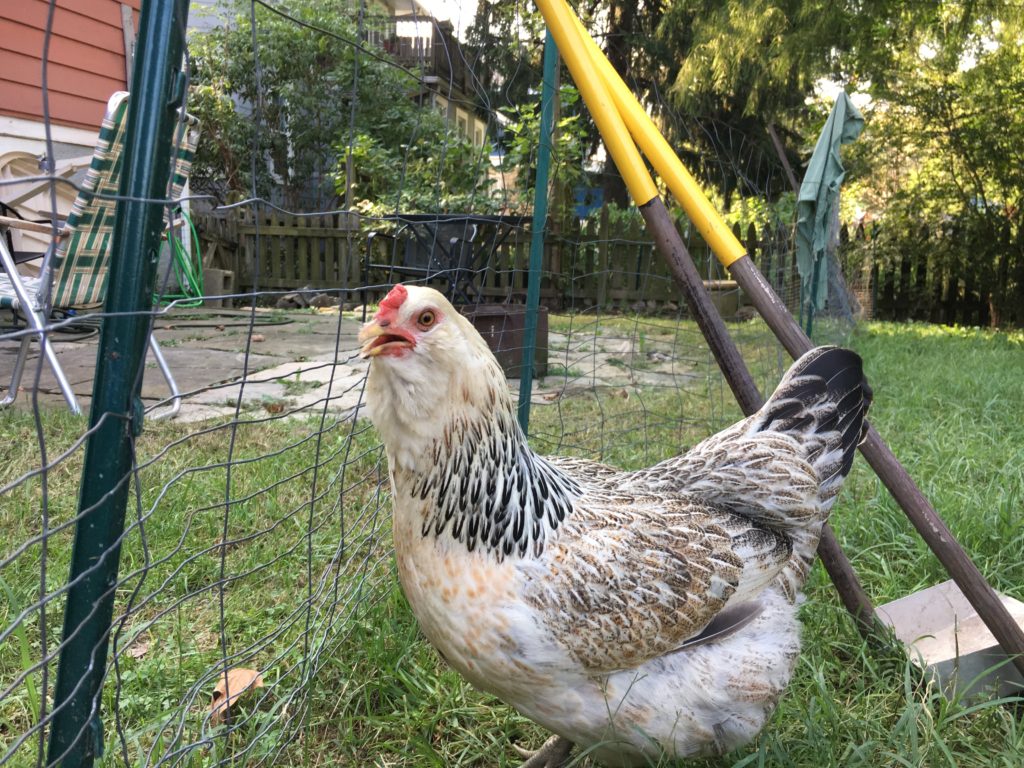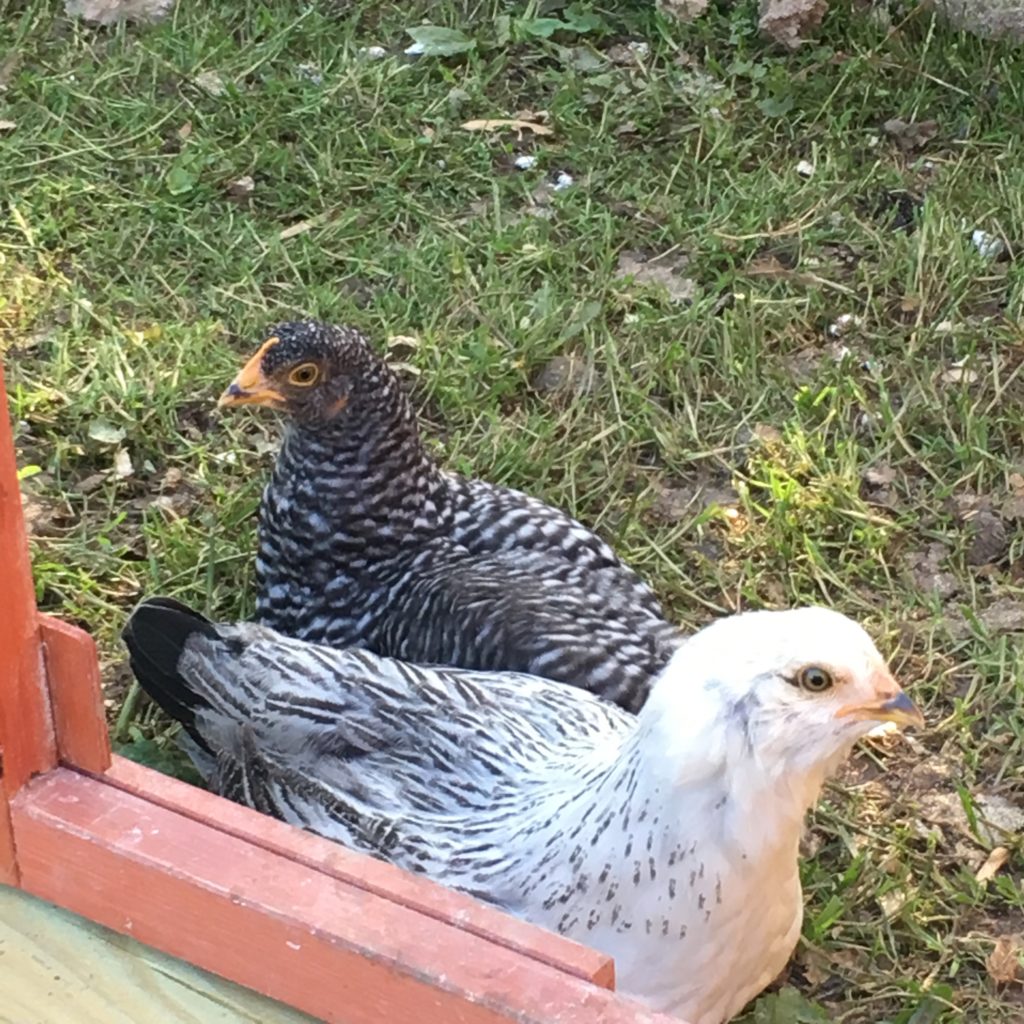Sandy Cryder lets us in on her adventures with acquiring and learning about beautiful Ameraucana hens, their history, looks, and moods.
New Chicks
Choosing the chicks for my new flock was great fun and a big challenge. In addition to looking for hardy layers that could tolerate both heat and cold, would rarely go broody, and have reasonably docile temperaments, I longed to have some lovely blue eggs. My decision-making process took me to web sites for mail order chicks, Craig’s List, chicken blogs, and eventually to the web site of Bowman’s Feed & Pet Store in nearby Westminster, MD. I decided to purchase from Bowman’s because they handle a large number of breeds, publish a list of breeds available every week, and I would have the chance to look over the chicks in person before I brought them home. Every week I carefully studied the traits of the available breeds and weighed the pros and cons of each. I thought about how each type of hen would interact with the others and how easy it would be to care for them. Finally, I settled on 3 Rhode Island Reds, 2 Barred Plymouth Rocks, 2 Delawares (a heritage cross breed from Barred Plymouth Rock rooster and New Hampshire hen), and 2 Ameraucanas.

The new flock of chicks. Photo by author.
Light or Dark?
Before plucking two Ameraucana chicks from the pen, the store employee asked, “Light or Dark?” I thought about it for a second and spontaneously replied, “One of each.” I hadn’t expected this choice, but the two little chicks were so cute! The dark one was dark brown with speckles, and the light one had a stripe down her back and was yellow and brown with speckled wings. The stripe made the light one look a little bit like a chipmunk from above – this made me smile!

La Gordita chick. Photo by E. Gillespie
To my surprise, as they grew from chick to pullet to hen, the light one (La Gordita) and the dark one (La Bonita) developed even more distinctly different looks.
Video Player
La Bonita grew into a sleek, beautiful, brown, black, orange and golden colored hen whose coloration makes me think of a pheasant. She has a sleek head and neck, a neat pea comb and a wattle that is barely visible.

La Bonita and a Delaware hen. Photo by author.
On the other hand, La Gordita, though by far the lightest weight of all the hens, looks chubby thanks to a muff that makes her neck look thick, and fluffy little puffs of feathers on her cheeks. She has no visible wattle. One of my granddaughters promptly named her ‘Chubby’. To soften the indignity of the name, I translated it to Spanish to make it a much more elegant sounding name.

La Gordita. Photo by author.
Like Lightening
These two hens are submissive and easy to pick up and handle unless …they are not in the mood, and then they run like crazy. They are very fast! Though La Bonita will struggle to jump down a minute or so after being picked up, La Gordita seems to like being picked up, held and petted. La Bonita and La Gordita both reliably lay 4-5 medium, pastel blue eggs each week.

La Gordita pullet with a Barred Rock hen. Photo by author.
Ameraucana from Araucana
It was only after these little chicks grew to hens that I became curious about the origins of this breed. The Ameraucana was developed in the U.S. in the 1970s, from Araucana chickens which come from Chile. The Araucana chickens carry a lethal gene that can cause death of the chick in the egg. The Ameraucana was developed to keep the blue egg laying characteristic while eliminating the lethal alleles.
Their Looks
Ameraucana chickens have tails, muffs and beards; small, round earlobes; small or absent wattles. Their earlobes, comb and wattles are all red, and their shanks (legs) are slate-blue to black. In addition to the Red-brown (La Bonita) and Silver (La Gordita) variety, Ameraucanas come in six other color variation: Black, Blue, Blue Wheaten, Buff, Wheaten and White. They also have large expressive eyes. Check out the photo of La Gordita giving the camera ‘the eye’!
My two Ameraucanas, now two years old, are excellent pets and egg layers. I recommend this breed and would choose them again.
Sandy Cryder is a Central Ohio transplant, happily living in Lauraville, a neighborhood in Northeast Baltimore, MD. A descendant of generations of farmers (including her paternal grandparents), Sandy takes great delight in keeping a flock of chickens in the backyard. When not tending to her chickens, she is busy shape note singing, learning Spanish, reading, writing, drawing and knitting. You can follow her through her website or Instagram.














4 Comments
These are not true Ameraucana, but Easter Eggers. Beautiful birds though, no matter the hybrid!
I have 2 Americaunas/ Easter eggers that I purchased as chicks last April 2020 along with 3 other breed chicks at the same time. My 3 no Americaunas began laying eggs consistently in October, but the Americaunas have still not begun laying yet. Is this unusual? I have not put any artificial light in the coop.
As I recall, the Americaunas were slower to begin laying. They also lay less frequently than my other hens and are not good winter layers. I hope this is helpful. I did a lot of research before starting my flock, and balanced out the lower rate of egg production of the Americaunas by getting just 2, and filling out the flock with Delaware and Barred Rock hens.
I loved your article on ameraucanas . It was cute.